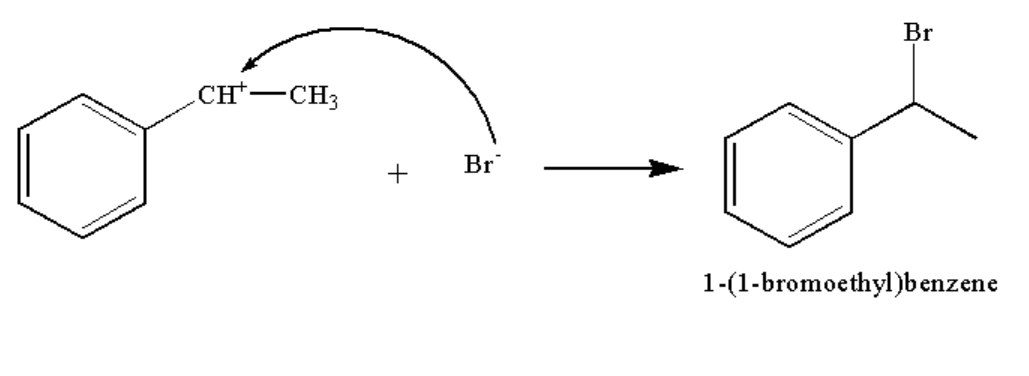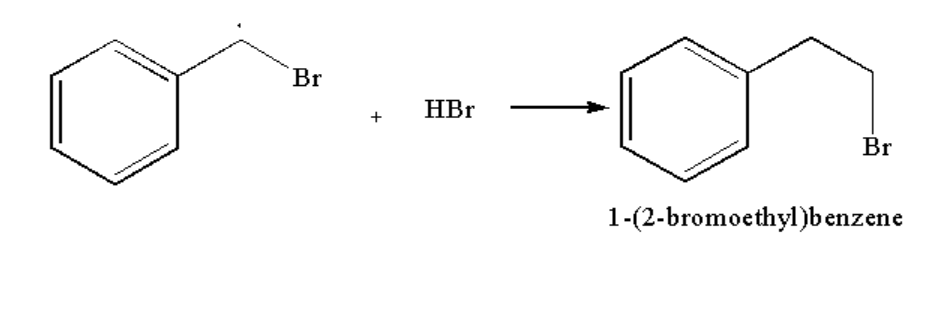
Analyse the following reaction and identify the nature of A and B.

Answer
221.1k+ views
Hint: The chemical name of HBr is hydrogen bromide. In the given reaction it should be noted that one reaction is taking place in presence of light and other in the absence of light. The reaction taking place in the presence of light forms free radicals.
Complete Step by Step Solution:
The reaction of a given compound with hydrogen bromide is an electrophilic addition reaction.
In an electrophilic addition reaction, the substrate is first attacked by an electrophile which results in the addition of an atom or molecule across multiple bonds.
In the first step, hydrogen bromide breaks to form hydrogen ion and bromide ion.
The reaction is shown below.
\[HBr \to {H^ + } + B{r^ - }\]
Image: Step 1: Formation of electrophile
In the second step, the hydrogen ion attack the double bond and a carbocation complex is formed.
The reaction is shown below.

Image: Step 2: Formation of carbocation
In the third step, the bromide ion attacks the carbocation to form the compound A.
The reaction is shown below.

Image: Step 3: Formation of compound A
The reaction of a given compound with hydrogen bromide in presence of light is a free radical addition reaction.
Free radical addition reaction involves the addition of free radicals. Free radicals are formed by homolytic cleavage.
The hydrogen bromide undergoes homolysis to form a free radical of hydrogen and bromine.
The reaction is shown below.

Image: Step 1: Free radical formation
Next, bromine radical is added to the compound

Image: Step 2

Image: Step 3: Formation of compound B
Therefore compound A is 1-(1-bromoethylbenzene) and compound B is 1-(2-bromoethyl)benzene.
Note: The anti-Markovnikov free radical addition of haloalkane only takes place in HBr in presence of hydrogen peroxide. Hydrogen peroxide starts the chain reaction in the initiation step..
Complete Step by Step Solution:
The reaction of a given compound with hydrogen bromide is an electrophilic addition reaction.
In an electrophilic addition reaction, the substrate is first attacked by an electrophile which results in the addition of an atom or molecule across multiple bonds.
In the first step, hydrogen bromide breaks to form hydrogen ion and bromide ion.
The reaction is shown below.
\[HBr \to {H^ + } + B{r^ - }\]
Image: Step 1: Formation of electrophile
In the second step, the hydrogen ion attack the double bond and a carbocation complex is formed.
The reaction is shown below.

Image: Step 2: Formation of carbocation
In the third step, the bromide ion attacks the carbocation to form the compound A.
The reaction is shown below.

Image: Step 3: Formation of compound A
The reaction of a given compound with hydrogen bromide in presence of light is a free radical addition reaction.
Free radical addition reaction involves the addition of free radicals. Free radicals are formed by homolytic cleavage.
The hydrogen bromide undergoes homolysis to form a free radical of hydrogen and bromine.
The reaction is shown below.

Image: Step 1: Free radical formation
Next, bromine radical is added to the compound

Image: Step 2

Image: Step 3: Formation of compound B
Therefore compound A is 1-(1-bromoethylbenzene) and compound B is 1-(2-bromoethyl)benzene.
Note: The anti-Markovnikov free radical addition of haloalkane only takes place in HBr in presence of hydrogen peroxide. Hydrogen peroxide starts the chain reaction in the initiation step..
Recently Updated Pages
The hybridization and shape of NH2 ion are a sp2 and class 11 chemistry JEE_Main

What is the pH of 001 M solution of HCl a 1 b 10 c class 11 chemistry JEE_Main

Aromatization of nhexane gives A Benzene B Toluene class 11 chemistry JEE_Main

Show how you will synthesise i 1Phenylethanol from class 11 chemistry JEE_Main

The enolic form of acetone contains a 10sigma bonds class 11 chemistry JEE_Main

Which of the following Compounds does not exhibit tautomerism class 11 chemistry JEE_Main

Trending doubts
JEE Main 2026: Application Form Open, Exam Dates, Syllabus, Eligibility & Question Papers

Derivation of Equation of Trajectory Explained for Students

Hybridisation in Chemistry – Concept, Types & Applications

Understanding the Angle of Deviation in a Prism

How to Convert a Galvanometer into an Ammeter or Voltmeter

Degree of Dissociation: Meaning, Formula, Calculation & Uses

Other Pages
NCERT Solutions For Class 11 Chemistry Chapter 7 Redox Reaction

JEE Advanced Marks vs Ranks 2025: Understanding Category-wise Qualifying Marks and Previous Year Cut-offs

Hydrocarbons Class 11 Chemistry Chapter 9 CBSE Notes - 2025-26

Thermodynamics Class 11 Chemistry Chapter 5 CBSE Notes - 2025-26

NCERT Solutions ForClass 11 Chemistry Chapter Chapter 5 Thermodynamics

Equilibrium Class 11 Chemistry Chapter 6 CBSE Notes - 2025-26




